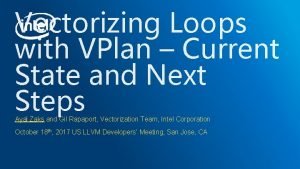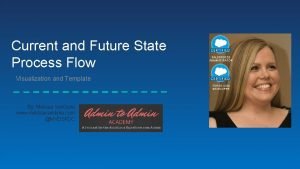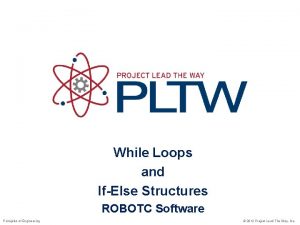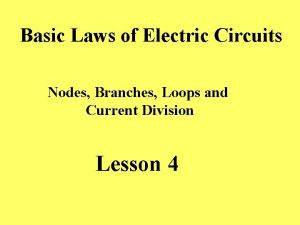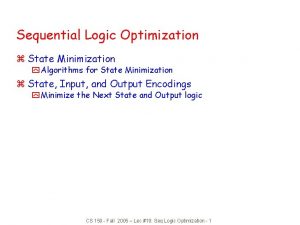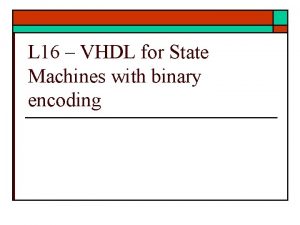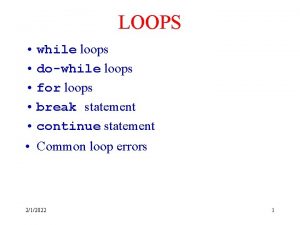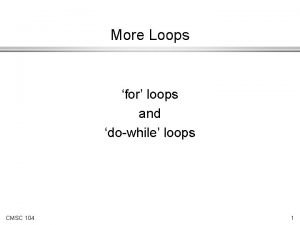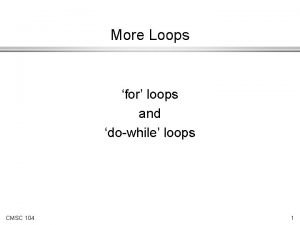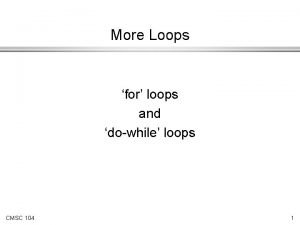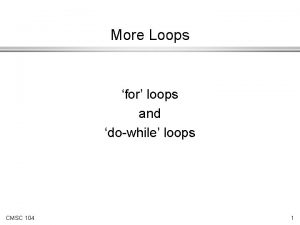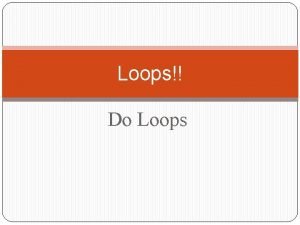Vectorizing Loops with VPlan Current State and Next






![VPlan Model: Current State void foo(int for (int i if (a[i] = } *a, VPlan Model: Current State void foo(int for (int i if (a[i] = } *a,](https://slidetodoc.com/presentation_image_h/2c2677cd33c6041d5e948843c996fe58/image-7.jpg)


![VPlan Model: Next Step void foo(int for (int i if (a[i] = } *a, VPlan Model: Next Step void foo(int for (int i if (a[i] = } *a,](https://slidetodoc.com/presentation_image_h/2c2677cd33c6041d5e948843c996fe58/image-10.jpg)











![A Model for Vectorized Instructions? *Shuffle jumbled load [D 31610] <c[0], c[1], c[2], c[3]> A Model for Vectorized Instructions? *Shuffle jumbled load [D 31610] <c[0], c[1], c[2], c[3]>](https://slidetodoc.com/presentation_image_h/2c2677cd33c6041d5e948843c996fe58/image-22.jpg)


- Slides: 24

Vectorizing Loops with VPlan – Current State and Next Steps Ayal Zaks and Gil Rapaport, Vectorization Team, Intel Corporation October 18 th, 2017 US LLVM Developers’ Meeting, San Jose, CA

Legal Disclaimer & Optimization Notice INFORMATION IN THIS DOCUMENT IS PROVIDED “AS IS”. NO LICENSE, EXPRESS OR IMPLIED, BY ESTOPPEL OR OTHERWISE, TO ANY INTELLECTUAL PROPERTY RIGHTS IS GRANTED BY THIS DOCUMENT. INTEL ASSUMES NO LIABILITY WHATSOEVER AND INTEL DISCLAIMS ANY EXPRESS OR IMPLIED WARRANTY, RELATING TO THIS INFORMATION INCLUDING LIABILITY OR WARRANTIES RELATING TO FITNESS FOR A PARTICULAR PURPOSE, MERCHANTABILITY, OR INFRINGEMENT OF ANY PATENT, COPYRIGHT OR OTHER INTELLECTUAL PROPERTY RIGHT. Software and workloads used in performance tests may have been optimized for performance only on Intel microprocessors. Performance tests, such as SYSmark and Mobile. Mark, are measured using specific computer systems, components, software, operations and functions. Any change to any of those factors may cause the results to vary. You should consult other information and performance tests to assist you in fully evaluating your contemplated purchases, including the performance of that product when combined with other products. Copyright © 2017, Intel Corporation. All rights reserved. Intel, Pentium, Xeon Phi, Core, VTune, Cilk, and the Intel logo are trademarks of Intel Corporation in the U. S. and other countries. Optimization Notice Intel’s compilers may or may not optimize to the same degree for non-Intel microprocessors for optimizations that are not unique to Intel microprocessors. These optimizations include SSE 2, SSE 3, and SSSE 3 instruction sets and other optimizations. Intel does not guarantee the availability, functionality, or effectiveness of any optimization on microprocessors not manufactured by Intel. Microprocessor-dependent optimizations in this product are intended for use with Intel microprocessors. Certain optimizations not specific to Intel microarchitecture are reserved for Intel microprocessors. Please refer to the applicable product User and Reference Guides for more information regarding the specific instruction sets covered by this notice. Notice revision #20110804 Optimization Notice Copyright © 2017, Intel Corporation. All rights reserved. *Other names and brands may be claimed as the property of others. 2

Key Takeaways A. Current State: 1 st step introducing VPlan to Loop Vectorizer – committed 1. Records vectorization decisions in VPlan 2. Drives vector code generation by executing a VPlan B. Going Forward: shift vectorization process to be VPlan-based 1. Refine the model, include masking and break Recipes into VPInstructions 2. Carry out decisions based on VPlan, in addition to recording them 3. Make decisions based on VPlan, including legal and cost-based analyses Optimization Notice Copyright © 2017, Intel Corporation. All rights reserved. *Other names and brands may be claimed as the property of others. 3

Recap: Loop Vectorization Plan Construc t 1. Legality Abandon 2. Planning VPlans. 0 Transform Cost Model Execute Uniform Branches VPlans. 1 Cost Model Execute Transform Interleave Groups VPlans. N Cost Model Execute Select Have clear VPlans, straightforward Cost & Execute Optimization Notice Copyright © 2017, Intel Corporation. All rights reserved. *Other names and brands may be claimed as the property of others. Best VPlan. N Cost Model Execute Execut e 4

A. Current state of vplan

1 st Step Committed: VPlan Refactors Transform Predicated Instructions 1. Legality Sink After Interleave Groups Should be Scalarized 2. Cost Model Construc t VPlans Transform Select 3. Planning Best VPlan Transform Execut e Sink Scalar Operands Decisions taken up-front, during execute, or as post-pass Optimization Notice Copyright © 2017, Intel Corporation. All rights reserved. *Other names and brands may be claimed as the property of others. 6
![VPlan Model Current State void fooint for int i if ai a VPlan Model: Current State void foo(int for (int i if (a[i] = } *a,](https://slidetodoc.com/presentation_image_h/2c2677cd33c6041d5e948843c996fe58/image-7.jpg)
VPlan Model: Current State void foo(int for (int i if (a[i] = } *a, int b, int *c) { = 0; i < 10000; ++i) > 777) b – (c[100*i] * 7 + a[i]) / b; LLVM-IR Before Vectorizer for. body: %indvars. iv = phi i 64 [ 0, %entry ], [ %indvars. iv. next, %for. inc ] %arrayidx = getelementptr inbounds i 32, i 32* %a, i 64 %indvars. iv %0 = load i 32, i 32* %arrayidx, align 4 %cmp 1 = icmp sgt i 32 %0, 777 br i 1 %cmp 1, label %if. then, label %for. inc if. then: %1 = mul nuw nsw i 64 %indvars. iv, 100 %arrayidx 3 = getelementptr inbounds i 32, i 32* %c, i 64 %1 %2 = load i 32, i 32* %arrayidx 3, align 4 %mul 4 = mul nsw i 32 %2, 7 %add = add nsw i 32 %mul 4, %0 %div = sdiv i 32 %add, %b %sub = sub nsw i 32 %b, %div store i 32 %sub, i 32* %arrayidx, align 4 br label %for. inc Optimization Notice Copyright © 2017, Intel Corporation. All rights reserved. *Other names and brands may be claimed as the property of others. VPlan for VF={2, 4, 8} 7

VPlan Model: Current State Recipe: models a sequence of instructions to appear in the vectorized code. May refer to Ingredients. Ingredient: element of the original scalar loop, such as an existing instruction. VPRecipe. Base void execute()= 0 VPBasic. Block *get. Parent() VPWiden. Recip e void execute() VPlan for Control-Flow Decisions Explicit, Data-Flow Decisions Implicit. VF={2, 4, 8} Optimization Notice Copyright © 2017, Intel Corporation. All rights reserved. *Other names and brands may be claimed as the property of others. 8

B. 1. model masking and instructions
![VPlan Model Next Step void fooint for int i if ai a VPlan Model: Next Step void foo(int for (int i if (a[i] = } *a,](https://slidetodoc.com/presentation_image_h/2c2677cd33c6041d5e948843c996fe58/image-10.jpg)
VPlan Model: Next Step void foo(int for (int i if (a[i] = } *a, int b, int *c) { = 0; i < 10000; ++i) > 777) b – (c[100*i] * 7 + a[i]) / b; VPValue VPUsers users() VPRecipe. Base void execute()= 0 VPBasic. Block *get. Parent() VPUser VPValues operands() VPInterleave void execute() Model Masking in VPlan using Def/Use Relations [D 38676] Optimization Notice Copyright © 2017, Intel Corporation. All rights reserved. *Other names and brands may be claimed as the property of others. 10

VPlan Model: Next Step (cont’d) VPlan for VF={2, 4, 8, 16} void foo(int* a, int b, int* c) { for (int i = 0; i < 10000; ++i) if (a[i] > 777) { c[i] = b; if (a[i] > 888) a[i] = b; } } VPRecipe. Base VPValue VPUsers users() void execute()= 0 VPBasic. Block *get. Parent() VPUser VPValues operands() VPInstruction void execute() uint get. Opcode() VPInterleave void execute() VPInstruction: Instruction-level Modeling in VPlan [D 38676] Optimization Notice Copyright © 2017, Intel Corporation. All rights reserved. *Other names and brands may be claimed as the property of others. 11

B. 2. From recording decisions to carrying them out

Taking Decision (1/4): Interleave Groups void foo(int *a, int n, int *c) { for (int i = 0; i < n; ++i) a[i] = 3*c[2*i+1] + c[2*i]; } IR Before Vectorizer foo. body: … %0 = load i 32, %arrayidx %mul 1 = mul %0, 3 %1 = load i 32, %arrayidx 3 %add 4 = add %mul 1, %1 store %add 4, %arrayidx 5 … Ingredients VPlan for VF=4 VPInterleave. Recipe: %1 = load %arrayidx 3 %0 = load %arrayidx 1 VPWiden. Recipe: %mul 1 = mul %0, 3 %add 4 = add %mul 1, %1 store %add 4, %arrayidx 5 IR After Vectorizing for VF=4 vector. body: … %all = load <8 x i 32>, %5 %even = shufflevector %all, <0, 2, 4, 6> %odd = shufflevector %all, <1, 3, 5, 7> %6 = mul %odd, <3, 3, 3, 3> %9 = add %6, %even store %9, %12 … VPlan Execution Effectively hoists load %1 to join load %0 Optimization Notice Copyright © 2017, Intel Corporation. All rights reserved. *Other names and brands may be claimed as the property of others. 13

Taking Decision (2/4): Unravel 1 st Order Recurrence void sink_after(short *a, int *b, int n) { for (int i = 0; i < n; ++i) b[i] = (a[i] * a[i+1]); } IR Before Vectorizer IR After Vectorizer foo. body: %iv = phi i 64 [ 0, %entry ], [ %iv. next, %for. body ] %0 = phi i 16 [ %. pre, %entry ], [ %1, %for. body ] %conv = sext i 16 %0 to i 32 %iv. next = add nuw nsw i 64 %iv, 1 %arrayidx 2 = getelementptr i 16, i 16* %a, i 64 %iv. next %1 = load i 16, i 16* %arrayidx 2 %conv 3 = sext i 16 %1 to i 32 %mul = mul nsw i 32 %conv 3, %conv %arrayidx 5 = getelementptr i 32, i 32* %b, i 64 %iv store i 32 %mul, i 32* %arrayidx 5 %exitcond = icmp eq i 64 %indvars. iv. next, %n br i 1 %exitcond, label %for. end, label %for. body vector. body %iv = phi i 64 [ 0, %vec. ph ], [ %iv. next, %vec. body ] %recur = phi <4 x i 16> [ %recur. init, %vec. ph ], [ %wide. load, %vec. body ] … %3 = getelementptr inbounds i 16, i 16* %a, i 64 %2 %wide. load = load <4 x i 16>, <4 x i 16>* %5, align 2 %6 = shufflevector <4 x i 16> %recur, <4 x i 16> %wide. load, <4 x i 32> <3, 4, 5, 6> %7 = sext <4 x i 16> %6 to <4 x i 32> %8 = sext <4 x i 16> %wide. load to <4 x i 32> %9 = mul nsw <4 x i 32> %8, %7 … Phase-ordering: first sink cast after load, then hoist interleave load [PR 34743] Optimization Notice Copyright © 2017, Intel Corporation. All rights reserved. *Other names and brands may be claimed as the property of others. 14

Taking Decision (3/4): Predication • Must convert divergent branches using masking • Much more challenging for outer-loop vectorization julb = hmin(jlb(i)); juub = hmax(jub(i)); cont 1 = T; for (j = julb; j < juub; ++j) { if (jlb(i) <= j && j < jub(i) && cont 1) { cont 2 = cond(i, j); while (hor(cont 2)) { if (cont 2) { … // vectorize here cont 2 = cond(i, j); for (i = ilb; i < iub; ++i) { } … } for (j = jlb(i); j < jub(i); ++j) { if (…) cont 1 = F; while (cond(i, j)) { … } if (!hor(cont 1)) break; if (…) break; } }Predication Decisions by Transforming } One VPlan to Another Take } • Earlier today: VPlan + RV: A Proposal by Simon Moll and Sebastian Hack • Last year’s Extending Loop. Vectorizer: by Hideki Saito: Optimization Notice Copyright © 2017, Intel Corporation. All rights reserved. *Other names and brands may be claimed as the property of others. 15

Taking Decision (4/4): Sink. Scalar. Operands Requires Fine-grain Modeling of Def/Use at instruction-level Optimization Notice Copyright © 2017, Intel Corporation. All rights reserved. *Other names and brands may be claimed as the property of others. 16

B. 3. From CARRYING OUt decisions to making them

Use VPlan to also Make Vectorization Decisions • Instead of first making the decisions, and then using VPlan to carry them out • Run cost-based analyses on VPlan • Based on cost estimates computed by VPlan • Based on VPInstruction model • Apply desired decisions by transforming VPlan, potentially versioning it • Based on “what-if” versioning support Optimization Notice Copyright © 2017, Intel Corporation. All rights reserved. *Other names and brands may be claimed as the property of others. 18

Expand VPlan’s Scope Beyond Vector Loop Body VPlans Loop Vectorization Another dimension to expand VPlan’s coverage Optimization Notice Copyright © 2017, Intel Corporation. All rights reserved. *Other names and brands may be claimed as the property of others. Execute 19

Taking Decision (1/4): Interleave Groups – revisit void foo(int *a, int n, int *c) { for (int i = 0; i < n; ++i) a[i] = 3*c[2*i+1] + c[2*i]; } IR Before Vectorizer foo. body: … %0 = load i 32, %arrayidx %mul 1 = mul %0, 3 %1 = load i 32, %arrayidx 3 %add 4 = add %mul 1, %1 store %add 4, %arrayidx 5 … Ingredients VPlan for VF=4 VPInterleave. Recipe: %1 = load %arrayidx 3 %0 = load %arrayidx 1 VPWiden. Recipe: %mul 1 = mul %0, 3 %add 4 = add %mul 1, %1 store %add 4, %arrayidx 5 IR After Vectorizing for VF=4 vector. body: … %all = load <8 x i 32>, %5 %even = shufflevector %all, <0, 2, 4, 6> %odd = shufflevector %all, <1, 3, 5, 7> %6 = mul %odd, <3, 3, 3, 3> %9 = add %6, %even store %9, %12 … VPlan Execution Combining two load %0, %1 into one load %all – looks familiar? Optimization Notice Copyright © 2017, Intel Corporation. All rights reserved. *Other names and brands may be claimed as the property of others. 20

A Model for Vectorized Instructions? void foo(int * restrict a, int b, int *c) { a[0] = c[0] * 7 + a[0]; a[1] = c[2] * 7 + a[1]; a[2] = c[1] * 7 + a[2]; a[3] = c[3] * 7 + a[3]; } opt -slp-vectorizer –view-slp-tree -… Optimization Notice Copyright © 2017, Intel Corporation. All rights reserved. *Other names and brands may be claimed as the property of others. 21
![A Model for Vectorized Instructions Shuffle jumbled load D 31610 c0 c1 c2 c3 A Model for Vectorized Instructions? *Shuffle jumbled load [D 31610] <c[0], c[1], c[2], c[3]>](https://slidetodoc.com/presentation_image_h/2c2677cd33c6041d5e948843c996fe58/image-22.jpg)
A Model for Vectorized Instructions? *Shuffle jumbled load [D 31610] <c[0], c[1], c[2], c[3]> <0, 2, 1, 3> void foo(int * restrict a, int b, int *c) { a[0] = c[0] * 7 + a[0]; a[1] = c[2] * 7 + a[1]; a[2] = c[1] * 7 + a[2]; a[3] = c[3] * 7 + a[3]; } Def/Use Model for New & Ingredient-based Instructions & Dependences opt -slp-vectorizer* -slp-view-tree -… Optimization Notice Copyright © 2017, Intel Corporation. All rights reserved. *Other names and brands may be claimed as the property of others. 22

Key Takeaways A. Current State: 1 st step introducing VPlan to Loop Vectorizer – committed 1. Records vectorization decisions in VPlan 2. Drives vector code generation by executing a VPlan B. Going Forward: shift vectorization process to be VPlan-based 1. Refine the model, include masking and break Recipes into VPInstructions 2. Carry out decisions based on VPlan, in addition to recording them 3. Make decisions based on VPlan, including legal and cost-based analyses Optimization Notice Copyright © 2017, Intel Corporation. All rights reserved. *Other names and brands may be claimed as the property of others. 23

 Vectorizing matlab
Vectorizing matlab X.next = x.next.next
X.next = x.next.next Llvm vplan
Llvm vplan Westerbergs купить
Westerbergs купить S r flip flop excitation table
S r flip flop excitation table Current state vs future state slide
Current state vs future state slide Line currents
Line currents Difference between phase voltage and line voltage
Difference between phase voltage and line voltage Semiconductor
Semiconductor Ac theory 3 lesson 4
Ac theory 3 lesson 4 Drift current
Drift current What is diffusion current and drift current
What is diffusion current and drift current In a ∆-connected source feeding a y-connected load
In a ∆-connected source feeding a y-connected load Holding current and latching current
Holding current and latching current Diffusion current density
Diffusion current density The constant-current region of a fet lies between
The constant-current region of a fet lies between In alternators the welding current is produced on the ____.
In alternators the welding current is produced on the ____. Hazard based safety engineering
Hazard based safety engineering Mesh current method with current source
Mesh current method with current source While loops and if-else structures
While loops and if-else structures Node branch
Node branch Small basic turtle commands
Small basic turtle commands Characteristic table of t flip-flop
Characteristic table of t flip-flop Next state
Next state Next state
Next state


